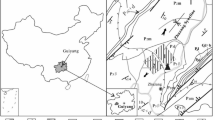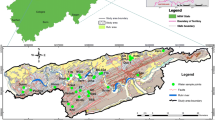Abstract
Acid mine drainage (AMD) is a common pollution in mining areas due to the oxidation of pyrite and associated sulfide minerals at mines, tailings and mine dumps. Elevated metals (Fe, Mn, Al) and metalloids (As, Hg) in AMD would deteriorate the local aquatic environment and influence the water supply. A carbonate basin with deposits of high-arsenic coal in Xingren County, southwestern China, was chosen to study the behavior of As and other chemical constituents along a river receiving AMD. Heavy metals (Fe, Mn) and major ions such as (Ca2+, Mg2+, Cl−, SO4 2−) in surface water, and As in sediment and surface water were analyzed. It was found that high concentrations of SO4 2− (1,324–7,560 mg/L) and Fe (369–1,472 mg/L) in surface water were mainly controlled by the interactions between water and rocks such as the oxidation of pyrite in the local coal seams, precipitation and adsorption of iron minerals. Although ubiquitous carbonate minerals in the bedrock and the riverbeds, low pH (<3) water was maintained until 2 km downstream from the AMD source due to the Fe(hydro)oxide minerals coating on the surface of carbonate minerals to restrain the neutralization of acidic water. Moreover, the formation of Fe(hydro)oxide precipitations absorbed As was dominated the attenuation of As from water to sediment. Whereas, the dilution also played an important role in decrease of As in river water.






Similar content being viewed by others
References
Achterberg EP, Herzl VMC, Braungardt CB, Millward GE (2003) Metal behavior in an estuary polluted by acid mine drainage: the role of particulate matter. Environ Pollut 121:283–292
Akcil A, Koldas S (2006) Acid Mine Drainage (AMD): causes, treatment and case studies. J Cleaner Prod 14:1139–1145
Alpers CN, Blowes DW, Nordstrom DK, Jambor JL (1994) Secondary minerals and acid mine water chemistry. In: Jambor JL, Blowes DW (eds) Environmental geochemistry of sulfide mine-wastes. Mineralogical Association of Canada, Montreal, pp 247–270
Asta MP, Cama J, Martinez M, Gimenez J (2009) Arsenic removal by goethite and jarosite in acidic conditions and its environmental implications. J Hazard Mater 171:965–972
Bigham JM, Nordstrom DK (2000) Iron and aluminum hydroxysulfates from acid sulfate waters. In: Alpers CN, Jambor JL, Nordstrom DK (eds) Reviews in mineralogy and geochemistry, sulfate minerals: crystallography, geochemistry, and environmental significance, vol 40. The Mineralogical Society of America, Washington, pp 351–403
Bigham JM, Schwertmann U, Traina SJ, Winland RL, Wolf M (1996) Schwertmannite and the chemical modeling of iron in acid sulfate waters. Geochim Cosmochim Acta 60:2111–2121
Bowell RJ, Bruce I (1995) Geochemistry of iron ochres and mine waters from Levant Mine, Cornwall. Appl Geochem 10:237–250
Cheng HF, Hu YA, Luo J, Xu B, Zhao JF (2009) Geochemical processes controlling fate and transport of arsenic in acid mine drainage (AMD) and natural systems. J Hazard Mater 165:13–26
Cravotta CA III (2008) Dissolved metals and associated constituents in abandoned coal-mine discharges, Pennsylvania, USA–2. Geochemical controls on constituent concentrations. Appl Geochem 23:203–226
Cravotta CA III, Trahan MK (1999) Limestone drains to increase pH and remove dissolved metals from acidic mine drainage. Appl Geochem 4:581–606
Cravotta CAI, Brady KBC, Rose AW, Douds JB (1999) Frequency distribution of the pH of coal-mine drainage in Pennsylvania DW. In US Geological Survey Toxic Substances Hydrology Program-Proc. (In: Morganwalp DW (ed) Technical Meeting, pp 313–324). Report 99-4018A. US Geological Survey, Water Resources Investigation
De Esparza ML (1998) Health risk assessment due to wastewater use in agriculture. Pure Appl Chem 70:2295–2299
Ding ZH, Zheng BS, Finkelman RB, Belkin HE, Chen CG, Zhou DX, Zhou YS (2000) Distribution and geochemistry of high arsenic coals from southwest Guizhou Province. Geochimica 29(5):490–494 (In Chinese)
Dzombak DA, Morel FMM (1990) Surface complexation modeling—hydrous ferric oxide. John Wiley, New York, p 393
Egiebor NO, Oni B (2007) Acid rock drainage formation and treatment: a review. Asia-Pac J Chem Eng 2:47–62
Fukushi K, Sasaki M, Sato T, Yanase N, Amano H, Ikeda H (2003) A natural attenuation of arsenic in drainage from an abandoned arsenic mine dump. Appl Geochem 18:1267–1278
Goldberg S, Glaubig RA (1988) Anion sorption on a calcareous, montmorillonitic soil-selenium. Soil Sci Soc Am J 4(52):954–958
Hedin RS, Watzlaf GR (1994) The effects of anoxic limestone drains on mine water chemistry. In: Proceedings of the international land reclamation and mine drainage conference and 3rd international conference on the abatement of acidic drainage, Pittsburgh, PA, 24–29 April 1994. Bureau of Mines Spec. Publ. SP06A-94. U.S. Dep. of the Int., Bureau of Mines, Washington, DC, pp 185–194
Jönsson J, Jönsson J, Lövgren L (2006) Precipitation of secondary Fe(III) minerals from acid mine drainage. Appl Geochem 21:437–445
Koryak M, Stafford LJ, Reilly RJ (2004) Declining intensity of acid mine drainage in the Northern Appalachian Bituminous coal fields: major Allegheny river tributaries. J Am Water Resour Assoc 40:677–689
Langmuir D (1997) Aqueous environmental geochemistry. Prentice-Hall, New Jersey
Lee JE, Kim Y (2008) A quantitative estimation of the factors affecting pH changes using simple geochemical data from acid mine drainage. Environ Geol 55:65–75
Li DS, An D, Zeng Z, Zhu AH, Zhang RZ (2004) Mortality of malignant tumor patient with endemic arsenism caused by coal-burning pollution in Gulzhou. China J End 23(1):42–45 (In Chinese)
Lin C, Tong X, Lu W, Yan L, Wu Y, Nie C, Chu C, Long J (2005) Environmental impacts of surface mining on mined lands, affected streams and agricultural lands in the Dabaoshan mine region, southern China. Land Degrad Dev 16:463–474
Meng X, Korfiatis GP, Bang S, Bang KW (2002) Combined effects of anions on arsenic removal by iron hydroxides. Toxicol Lett 133:103–111
Nordstrom DK (1982) The effect of sulfate on aluminum concentrations in natural waters: some stability relations in the system Al2O3-SO3–H2O at 298 K. Geochim Cosmochim Acta 46:681–692
Parkhurst DL, Appelo CAJ (1999) User’s guide to Phreeqc (Version 2)—A computer program for speciation, batch-reaction, one-dimensional transport, and inverse geochemical calculations. US department of the interior US geological survey. Water-Resources Investigations Report 99-4259. p 98
Postgate JR (1984) The Sulfate Reducing Bacteria. Cambridge University Press, Cambridge
Powell JD (1988) Origin and influence of coal mine drainage on streams of the United States. Environ Geol Water Sci 11:141–152
Robbins EI, Cravotta CA III, Savela CE, Nord GL (1999) Hydrobiogeochemical interactions in “anoxic” limestone drains for neutralization of acidic mine drainage. Fuel 78:259–270
Tao X (2008) A natural attenuation of As in river system from high-arsenic coal mining area in Xingren County. Master paper of Guizhou University, pp 35–38. (Unpublished)
Tiwary RK (2001) Environmental impact of coal mining on water regime and its management. Water Air Soil Pollut 132:185–199
Wang Y (1994) Distribution characteristics of trace elements in coal and its combustion. Dissertation in graduate department of China University of Mining & Technology (Beijing), p 11
Webster JG, Swedlund PJ, Webster KS (1998) Trace metal adsorption onto an acid mine drainage iron(III) oxy hydroxy sulfate. Environ Sci Technol 32:1361–1368
Welch AH, Stollenwerk KG (2002) In: Welch AH, Stollenwerk KG (eds) Arsenic in groundwater. Kluwer academic publishers, Boston, Dordrecht, London, p 68
Wilkie JA, Hering JG (1996) Adsorption of arsenic onto hydrous ferric oxide: effects of adsorbate/adsorbent ratios and co-occurring solutes. Colloids Surf A: Physicochem Eng Aspects 107:97–110
Wu P, Tang CY, Liu CQ, Zhu LJ, Pei TQ, Feng LJ (2009) Geochemical distribution and removal of As, Fe, Mn and Al in a surface water system affected by acid mine drainage at a coalfield in Southwestern China. Environ Geol 57:1457–1467
Xie F, He JL, Tan H, Deng QJ, Song CR, Chen AN, Ji YB (2006) Determination of cadmium, arsenic and mercury in soil with nitric acid digestion technique. Chin J Soil Sci 37:340–342 (In Chinese)
Zhao FH, Ren DY, Peng SP, Wang YQ, Zhang JY, Ding ZH, Cong ZY (2003) The modes of occurrence of Arsenic in coal. Adv Earth Sci 18(2):214–220 (In Chinese)
Zhou DX, Liu DN, Zhu SL, Zhou CL (1993) Investigation of chronic arsenic poisoning caused by high-arsenic coal pollution. Chin J Prev Med 27:147–150 (In Chinese)
Acknowledgments
We gratefully acknowledge the analytical support by Rongsheng Huang and Hongwen Leng who work in Institute of Geochemistry, Chinese Academy of Sciences, Guiyang, China, and Feng Xie who works in Test center on Physical–Chemical Analysis of Guizhou Province, China. The authors also are grateful to the supports from China Scholarship Council. Moreover, the authors would like to thank the editor and anonymous reviewers for their helpful comments and criticisms of both the English and the scientific writing of the revised manuscript. This project was financially supported by the National Natural Science Foundation of China (40963005) and Key Discipline Construction Project of Guizhou University (Karst200902).
Author information
Authors and Affiliations
Corresponding author
Rights and permissions
About this article
Cite this article
Tao, X., Wu, P., Tang, C. et al. Effect of acid mine drainage on a karst basin: a case study on the high-As coal mining area in Guizhou province, China. Environ Earth Sci 65, 631–638 (2012). https://doi.org/10.1007/s12665-011-1110-0
Received:
Accepted:
Published:
Issue Date:
DOI: https://doi.org/10.1007/s12665-011-1110-0




